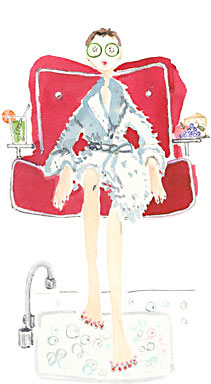
You can see straight through a bad pickup line. (Stars in your eyes? Puh-leez.) But when it comes to beauty, there are still some falsehoods floating around that you might not be on to yet. Get ready to wise up.
MSN Lifestyle
THE MYTH: Using more of a product will make it work faster.
THE TRUTH: “In most cases, heaping on a skin-care product is only going to land you in the dermatologist’s office faster,” says Kenneth Beer, a dermatologist in Palm Beach, Florida. “Anything that contains an active ingredient will irritate your skin if you overdo it.” The most common active ones are vitamin C, retinol, and alpha hydroxy acids (like glycolic), which work to smooth the skin and soften lines, and beta-hydroxy acids (like salicylic) and benzoyl peroxide, which clear breakouts. If you’re using something that contains these ingredients, apply just enough to barely cover the area you’re treating. If you’re using a retinol cream, for example, a pea-size dab will do the trick.
THE MYTH: Everyone needs to use a toner.
THE TRUTH: “Ninety percent of people using toners shouldn’t be,” says Ranella Hirsch, a dermatologist in Cambridge, Massachusetts. “In most cases, they strip the skin of the oil it needs to stay soft.” Just cleansing is enough to remove surface dirt and oils.
But what about that dark stuff you see on the cotton ball after you cleanse? It’s not dirt. It’s healthy oils that darken when exposed to air. So who should use a toner? Only people with very oily or acne-prone skin. If this is you, look for one with alcohol and salicylic acid to fight breakouts.
THE MYTH: You can get addicted to your favorite lip balm.
THE TRUTH: There’s no basis to the conspiracy theory that lip balms are spiked with ingredients that make your lips drier (so you have to use them more often and replenish your stash). “Balms simply make your lips look and feel soft, so we tend to reapply them as soon as they wear off,” says New York City dermatologist Doris Day. “But there’s no possibility of physical addiction.”
The real issue, explains Dr. Beer, is that lip-balm application is often accompanied by lip licking. “That constant wetting and drying becomes a habit, and that’s what depletes moisture.” To stop the cycle and start fresh, apply cortisone cream to your lips and top it with Vaseline for a week. Then stick to balms that contain petrolatum, glycerin, or mineral oil — they won’t rub off easily or irritate your lips.
THE MYTH: The more SPF products you layer on, the higher your level of sun protection will be.
THE TRUTH: Between your SPF 30 moisturizer, SPF 15 foundation, and SPF 10 powder, you probably think you’re up to an SPF of 55, right? Wrong. While your math is impressive, sun protection, unfortunately, isn’t cumulative. If you’re wearing layers of SPF, you’re only protected up to the highest number that you put on. So in this case, 30 plus 15 plus 10 equals...30.
THE MYTH: Everyone needs to buy a separate eye cream.
THE TRUTH: The skin around your eyes is the thinnest on your body, so it needs a little extra TLC. But that doesn’t mean you need to drop a Benjamin on an itsy-bitsy jar of eye cream. “If you use a very hydrating face cream, there’s no reason you can’t apply it up to your eyes,” says Dr. Bank. “You don’t need another product.”
To avoid any problems, make sure your moisturizer is fragrance-free — fragrance is the number one cause of irritation in skin-care products. If it contains sunscreen (and in the a.m., it should), physical ray repellers (zinc oxide and titanium dioxide) are less likely to bother your eyes than chemical ones (avobenzone and oxybenzone) are. And even if you slap cream on the rest of your face, use your ring finger to dab it under your eyes and on your lids; it will keep you from tugging on delicate skin.
THE MYTH: You won’t see results if you don’t use a brand’s entire line.
THE TRUTH: That’s what the lady at the counter said before she asked for your credit card. But you may be doing your skin more service by picking and choosing products from different lines. “There are a lot of great skin-care companies, but no one has the market cornered,” says David Bank, a dermatologist in Mount Kisco, New York. “One might make a great moisturizer, another a fantastic cleanser. You should find the best combination for you.” Score samples so you can test out brands without breaking the bank. (Many department-store lines dole out freebies, and drugstore brands often have giveaways on their Websites.)
THE MYTH: Your mascara might go bad, but not the stuff you use on your skin.
THE TRUTH: No such luck. The night cream that’s been sitting on your dresser for two years? It’s probably not doing much for you at this point. Over time, the ingredients in face-care products evaporate or degrade, so they don’t work as well. If the product’s old enough that its preservatives have worn off, it’s also vulnerable to bacteria. “The rule of thumb is to replace any skin-related item after a year,” says New York City dermatologist Arielle Kauvar. That’s about how long preservatives remain stable. Some products now come with a label that tells you how many months (6, 12, 15...) they last after you’ve opened them. How do you remember when that was? Use a permanent marker to write the date on the bottom of the bottle.
- Aug 08 Sat 2015 11:30
7 Skin-Care Myths Busted
全站熱搜
 留言列表
留言列表
發表留言


 留言列表
留言列表
